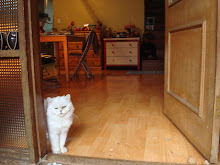
'The Girl with the Pearl Earring' might ring some bells because it is a a famous painting by Johannes Vermeer (1632-1675). I'm not going to post about the painting or the painter.

It is just a coincidence that I can also proudly call myself one.These pearls are cultured, they are beautiful and they are real. My pearl mania started when my classmates gave us pearl accessories as gifts and as a souvenir on their return from home in the Philippines about 2 years ago. They told us that pearls are dirt cheap there and I recently found out that they are among the major producers of fresh water pearls in the world. The other countries include Japan, Australia, China, Myanmar, Indonesia, India and Tahiti and actually, Japan controls roughly 80% of the world pearl market.
The art of culturing pearls was invented in Japan in 1893 by Kokichi Mikimoto and to this day, his family continues to be one of the largest pearl producing empires. Commercially freshwater pearl (cultural pearl) crops appeared in the 1930s near the great lakes of Kyoto. It is said that the Akoya pearls from Japan are some of the most lustrous and expensive among the fresh water pearls, selling for up to five thousand dollars.
Historically, the world's best pearls came from the Persian Gulf, especially around what is now Bahrain. The pearls of the Persian Gulf were naturally created and collected by breath-hold divers. The secret to the special luster of Gulf pearls is due to its unique mixture of sweet and salt water. Unfortunately, the natural pearl industry of the Persian Gulf ended abruptly in the early 1930's with the discovery of large deposits of oil and later on due to water pollution from oil spills. Still, Bahrain remains one of the foremost trading centers for high quality pearls and it is taken as a hobby. In fact, cultured pearls are banned from the Bahrain pearl market, in an effort to preserve the heritage.


















 sarahinsouthkorea
sarahinsouthkorea

No comments:
Post a Comment